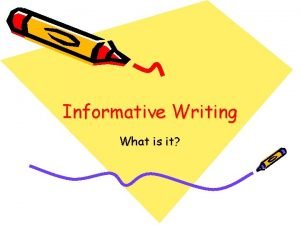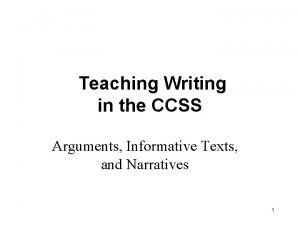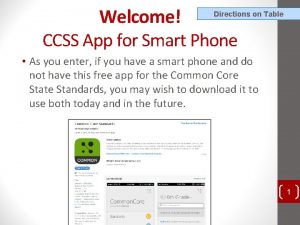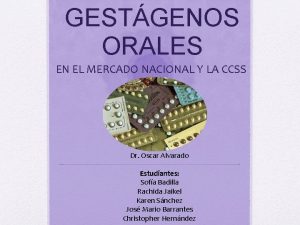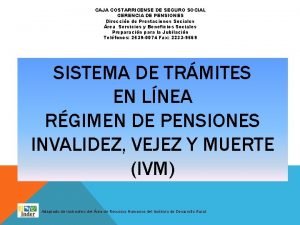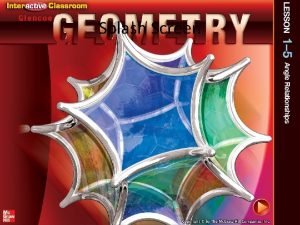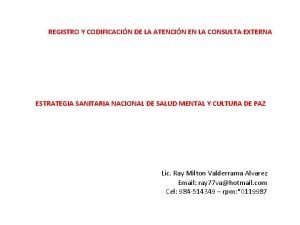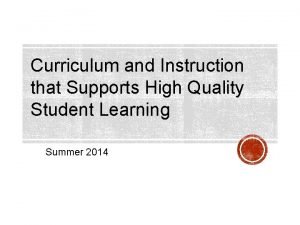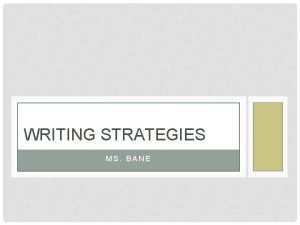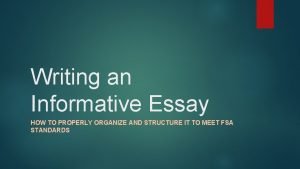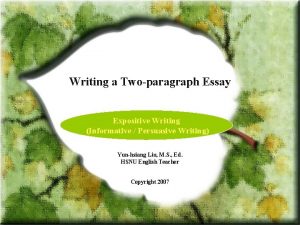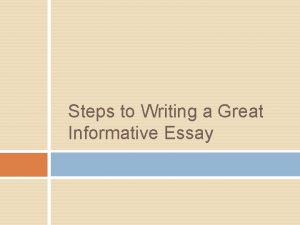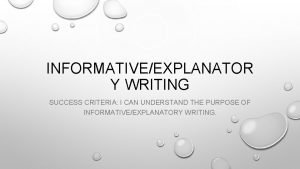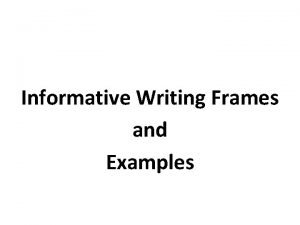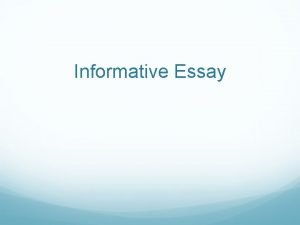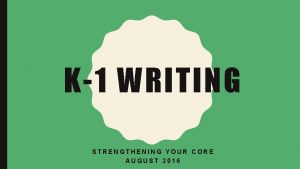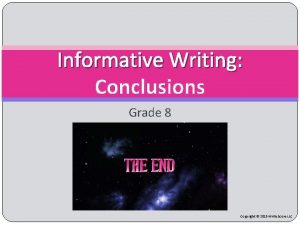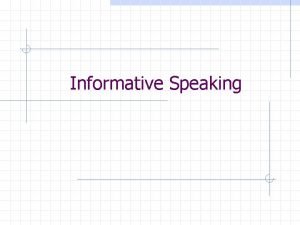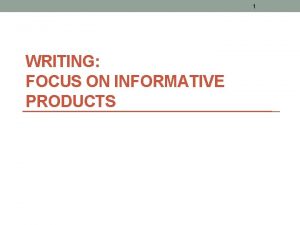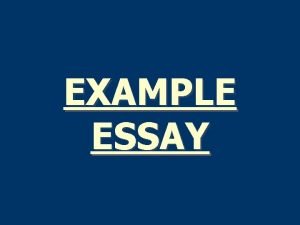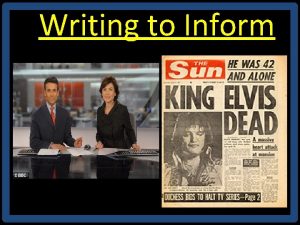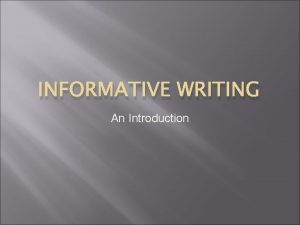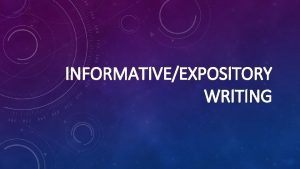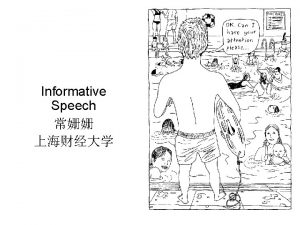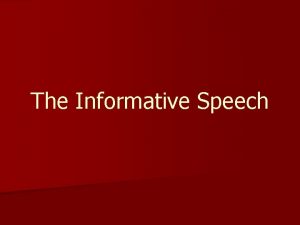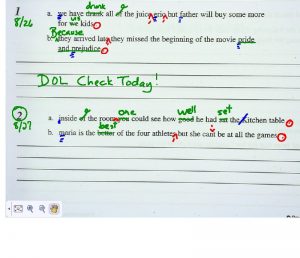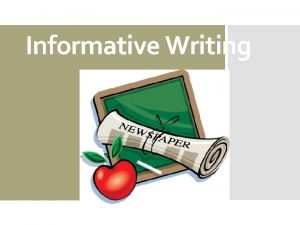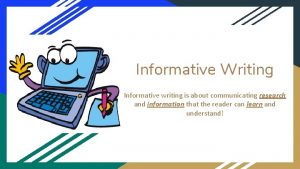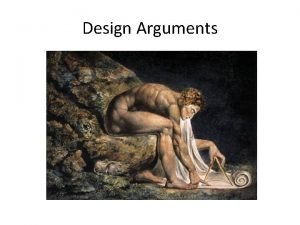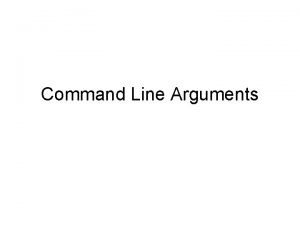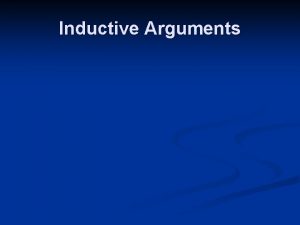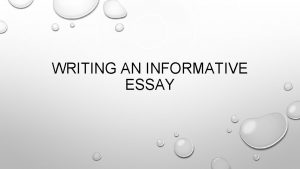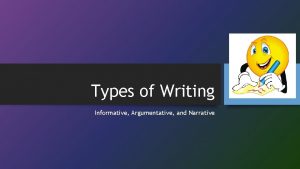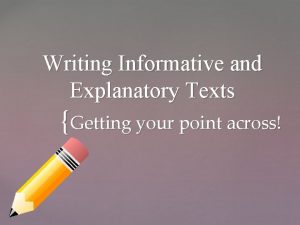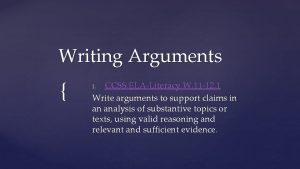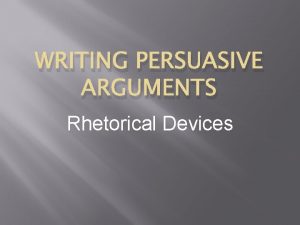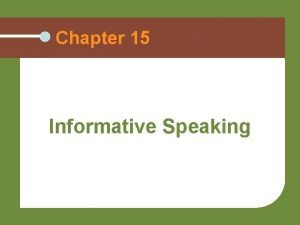Teaching Writing in the CCSS Arguments Informative Texts




















































- Slides: 52

Teaching Writing in the CCSS Arguments, Informative Texts, and Narratives 1

Writing is not caught. It must be taught. Anita L. Archer, Ph. D. archerteach@aol. com 2

Big Idea #1 - Focus on a limited number of genre Common Core State Standards Opinion/Argument - to convince Informative Text - to explain or inform Narrative - to convey an experience 3

Arguments - To convince • Definition – A reasoned, logical argument – Demonstrating that the writer’s position, belief, or conclusion is valid • Purpose – Change reader’s point of view – Bring about some action on reader’s part – Ask reader to accept writer’s explanation • Genre – essay, letter, editorial 4

Informative Text To Explain or Inform • Definition – Text – That conveys information accurately • Purpose – To increase reader’s knowledge of subject – To help reader understand a procedure or process – To provide reader with enhanced understanding of concept • Genre – literary analyses, reports, summaries, comparisons, instructions, manuals, memos, resumes 5

Narratives To Convey an Experience • • • Definition – A written product – That conveys real or imagined experiences – Using time as the structure Purpose – To entertain – To inform – To instruct – To persuade Genre – fictional stories, memoirs, anecdotes, autobiographies 6

Big Idea #2: Teach the foundation skills to mastery. Outcome: Writing Arguments, Informational Texts, Narratives Example Foundation Skills: reading, expressive vocabulary, word usage, fluent handwriting or typing, spelling, grammar, capitalization, punctuation, sentence formation, sentence sense, paragraph formation 7

Big Idea #3 Make Standards Teachable • Condense and integrate the standards • Simplify without losing essence 8

Writing 3 rd Grade - CCSS 1. Opinion 2. Informative 3. Narrative 4. With guidance and support from adults, produce writing in which the development and organization are appropriate to task and purpose. 5. With guidance and support from peers and adults, develop and strengthen writing as needed by planning, revising, and editing. 6. With guidance and support from adults, use technology to produce and publish writing (using keyboarding skills) as well as to interact and collaborate with others. 9

Writing 3 rd Grade - CCSS 7. Conduct short research projects that build knowledge about a topic. 8. Recall information from experiences or gather information from print and digital sources; take brief notes on sources and sort evidence into provided categories. 9. (Not applied to 3 rd grade. ) 10. Write routinely over extended time frames (time for research, reflection, and revision) and shorter time frames (a single sitting or a day or two) for a range of discipline-specific tasks, purposes, and audiences. 10

Writing 3 rd Grade - CCSS Tasks • Write often • Short and long products • Variety of tasks, audiences, purposes • Purposes – to convince (Opinion) – to inform or explain (Informative) – to convey an experience (Narrative) 11

Writing 3 rd Grade - CCSS Writing Process Plan Gather information Personal experiences Print sources Digital sources Take notes on information Organize Sort information Organize appropriate to task, purpose, audience Write clearly and coherently Use technology Revise Edit Rewrite 12

Writing 7 th Grade - CCSS 1. Write arguments to support claims with clear reasons and relevant evidence. a. Introduce claim(s), acknowledge and address alternate or opposing claims, and organize the reasons and evidence logically. b. Support claim(s) or counterarguments with logical reasoning and relevant evidence, using accurate, credible sources and demonstrating an understanding of the topic or text. c. Use words, phrases, and clauses to create cohesion and clarify the relationships among claim(s), reasons, and evidence. d. Establish and maintain a formal style. e. Provide a concluding statement or section that follows from and supports the argument presented. 13

2. Informative 3. Narrative 4. Produce clear and coherent writing in which the development, organization, and style are appropriate to task, purpose, and audience. 5. With some guidance and support from peers and adults, develop and strengthen writing as needed by planning, revising, editing, rewriting, or trying a new approach, focusing on how well purpose and audience have been addressed. (Editing for conventions should demonstrate command of Language standards 1– 3 up to and including grade 7 on page 43. ) 14

6. Use technology, including the Internet, to produce and publish writing and link to and cite sources as well as to interact and collaborate with others, including linking to and citing sources 7. Conduct short research projects to answer a question, drawing on several sources and generating additional related, focused questions for further research and investigation. 15

8. Gather relevant information from multiple print and digital sources, using search terms effectively; assess the credibility and accuracy of each source; and quote or paraphrase the data and conclusions of others while avoiding plagiarism and following a standard format for citation. 9. Draw evidence from literary or informational texts to support analysis, reflection, and research. 16

10. Write routinely over extended time frames (time for research, reflection, and revision) and shorter time frames (a single sitting or a day or two) for a range of discipline-specific tasks, purposes, and audiences. 17

7 th Grade Writing - Tasks • Routine writing • Extended time - research projects allowing research, reflection, revision • Shorter time • Variety of tasks, audiences, purposes Purposes – to convince or persuade (Argument) – to inform or explain (Informative) – to convey an experience (Narrative) 18

7 th Grade Writing Critical Attributes for an Argument Introduction – Introduces claims – Acknowledges alternative claims/ counterarguments – Organizes reasons Body – Supports claims and counterarguments – With logical reasoning and relevant evidence – Uses transition words, phrases, clauses to create cohesion Conclusion – Contains concluding statement or section – That supports argument Overall – Conveys a reasoned, logical argument – Demonstrates understanding of topic – Maintains formal style – Has clear, coherent writing – Avoids plagiarism Conventions – Capitalization, punctuation, spelling – Standard format for citations 19

7 th Grade Writing - Writing Process Plan Research Gather information and evidence - Use multiple, credible sources -Print and digital sources -Evidence from literary and informational text Take notes on information Organize - Appropriate to task, audience, purpose Write Transcribe plan into clear, coherent writing Use technology Revise Edit Consider conventions Rewrite Publish/Share 20

Big Idea #4 - Break down complex tasks • Complex skills and strategies should be broken down into smaller, easy to obtain instruction units. • This will promote success and reduce cognitive overload. 21

Break down complex skills Body of Argument Transcription 1. When given a reason and related facts and details, can write a paragraph with a topic sentence stating the reason. 2. When given a reason and related facts and details, can write a paragraph with a topic sentence stating the reason followed by sentences containing facts and details, connected with transition words and phrases. 3. When given three reasons and related facts and details, can write three paragraphs each containing a topic sentence stating the reason followed by sentences containing supporting facts and details, connected with transition words and phrases. 22

Break down complex skills Body of Argument Planning and Transcribing 4. When given a topic, can generate a claim and reasons to support the claim. 5. When given a topic, can generate a claim and reasons to support the claim and details to logically support each reason. 6. When given a topic, can generate a plan for the body of an essay (the claim, the reasons, details to support each reason) and transcribe the plan into three coherent paragraphs When given a claim on a topic, can generate reasons to support that claim. 23

Break down complex skills. Example - Common Core Standards Introduction 7. For previously formulated argument papers, writes an introduction that: a) grabs the attention of the reader, b) states the writer’s opinion, and c) introduces reasons to support the writer’s opinion. Conclusion 8. For previously formulated argument papers, writes a short conclusion “wraps it up” the essay by: a) summarizing the opinion and reasons, b) calling for some action to be taken, or c) explaining the outcomes of not following the writer’s suggestions. Arguments (Desired Outcome) 9. . When given a topic, can plan, write, and edit an argument paper that includes: a) an effective introduction, b) a well structured body with logically organized reasons and related facts and details, linked with appropriate transition words and phrases, and c) a short conclusion that “wraps it up”. 24

Big Idea #5 Provide explicit instruction Remember - Writing is not caught. Writing must be taught. • Model I do it • Guided Practice We do it Gradual release of responsibility • Unguided Practice You do it 25

Provide Explicit Instruction • Scaffold Instruction, gradually fading out teacher assistance M I do it. T We do it. M T You do it. …. . W T We do it. W T You do it. …… F We do it. F You do it. 26

Big Idea # 6 Provide judicious practice • Engage students in writing for short and long time segments • Have students write many products of focus genre to promote mastery • After initial instruction, products can be composed in a variety of classes 27

Big Idea #7 Provide Immediate Feedback • Teacher feedback to individual: Provide feedback to individuals in real time as you circulate and monitor. Praise, Encourage, Correct • Teacher feedback to group: Provide feedback to the entire class on your observations. 28

Big Idea #7 Provide Immediate Feedback • Feedback to self: Have students carefully check their products against the rubric. • Feedback to partner: Have students give focused feedback to their partners after you model the feedback procedure. 29

Big Idea #7 Provide Immediate Feedback • Teacher Feedback: Provide feedback to students on a portion of the rubric. • Teacher Feedback: Provide feedback on final drafts using the rubric. To promote final drafts include a signature page: • • • ____________(Author) I have carefully revised and edited this paper. ____________(Peer) I have read this paper and have indicated errors to the author. ____________(Adult Mentor) I have read this paper and have indicated errors to the author. 30

Big Idea #8 Consider motivation • Consider motivation. – Success (perceived probability of success) – Interest (interest in the topic) – Choice (narrow choice when possible) 31

Big Idea #9 Frontload Writing • If students have no ideas, their written products will be low in quanity and quality. • Frontload IDEAS – Brainstorm ideas (Think, Pair, Share) – Read related materials – Relate to concepts that have been taught 32

Big Idea # 10 Teach “What” and “How” • WHAT What is the genre? – Critical attributes – Rubric – Example • HOW How to write the genre? – Writing Process 33

Review Big Ideas 1. 2. 3. 4. 5. 6. 7. 8. 9. 10. Focus on limited number of genre. Teach the critical foundation skills to mastery. Make standards teachable. Break down complex tasks. Provide explicit instruction. Provide judicious practice. Provide immediate feedback. Consider motivation. Frontload writing. Teach “What” and “How”. 34

WHAT • Ask yourself, what are the CRITICAL ATTRIBUTES of a wellwritten product. • Consider the Six Traits – – – Ideas Organization Word Choice Voice Sentence Fluency Conventions • Consider the descriptions in the Standards 35

What • Design a simple, easy to understand RUBRIC. • Consider introducing only a portion of the rubric initially. Focus on ideas (content), organization, and conventions. • Provide an EXAMPLE to illustrate the critical attributes. • (Optional) Guide students in analyzing a non-example to determine missing attributes. 36

WHAT Example # 1 – descriptive paragraph rubric and example – passage summary rubric, example and non -example 37

HOW • Writing process – Planning – Writing – Revising – Editing – Rewriting – Publishing - Plan - Write - Revise - Edit - Rewrite - Publish 38

HOW - Plan T = Task/Topic A = Audience P = Purpose Analyze Prompt 1. (children’s crimes) As you know, it is not just adults who commit crimes of robbery, assault, or murder. These can also be committed by youth. Many believe that parents should be jailed or fined for the crimes of their children. Do you agree or disagree with this action? Write an essay for the general public that argues your position. 39

HOW - Plan Think Use logical arguments and experiences or Research Gather evidence from a variety of digital and print sources 40

HOW - Plan - Organize Scaffold organization of written product – Writing frames – Strategies – Think Sheets 41

Frames Scaffold Organization - Writing frames • • • Use with beginning writers Use as an accommodation for emerging writers Use to support specialized writing Use to support summarization Use to promote comprehension of material Use to emphasize use of academic language 42

Frames • See examples. • Example #2. Beginning writers (basic paragraph) • Example #3. Accommodation for emerging writers (state report, mammal report) • Example #4. Specialized writing (story problem explanation) • Example # 5. Summarization narrative (story grammar) • Example # 6. Summarization expository • Example # 7. Comprehension responses • Example #8. Academic Language 43

Strategies Strategy for Paragraph Writing - List - Cross-out - Connect - Number ( Write) REWARDS PLUS (Sopris West) 44

List - Make a list of important ideas. Penquin’s birth – – – – – Male takes care of egg Female lays egg Female leaves Female spends winter at sea The water is very cold Male puts egg on his feet under belly Male stays on egg for two months Male doesn’t eat Egg hatches Male must care for baby 45

Cross-out - Cross out any unnecessary or weak ideas. Connect - Connect ideas that could go in one sentence. Penquin’s birth Male takes care of egg Female lays egg Female leaves Female spends winter at sea The water is very cold Male puts egg on his feet under belly Male stays on egg for two months Male doesn’t eat Egg hatches Male must care for baby 46

Number - Number the ideas in the order that they will appear in the paragraph. Penquin’s birth 3 1 2 4 6 Male takes care of egg Female lays egg Female leaves Female spends winter at sea The water is very cold Male puts egg on his feet under belly Male stays on egg for two months 5 Male doesn’t eat Egg hatches Male must care for baby 47

Write a summary. The birth process of penguins is fascinating and quite different from that of other animals. The female penguin lays an egg. Soon after laying the egg, the female penguin leaves and spends the winter in the sea. Meanwhile the male must take care of the egg. For two months, he places the egg on his feet under his belly. During this time, the male penguin doesn’t eat. Even after the baby penguin hatches, the male penguin continues to take care of the infant penguin. 48

Strategies • See Example #9 for summary writing – Strategy – Example of Strategy Use – Example Summary – Rubric REWARDS Plus (Sopris West) 49

Think Sheets Examples • Example # 10 – Think sheet for organizing compare/contrast – Example paragraph 50

Think Sheets • Example # 11 - Essay to convince – Example Rubric – Example Essay – Think Sheet • Example # 12 - Essay to explain/inform – Example Rubric – Example Essay – Think Sheet • Example #13 - Narrative – Example – Think Sheet 51

Thank You May we remember : Writing is not caught. It must be taught. 52
 Informative writing definition
Informative writing definition Informative texts definition
Informative texts definition Ccss app
Ccss app Hormofen y ciclotab 20
Hormofen y ciclotab 20 Ccss
Ccss Gerencia de pensiones
Gerencia de pensiones Ccss splash
Ccss splash Test de tamizaje para adolescentes de la ccss
Test de tamizaje para adolescentes de la ccss Ccss jpams
Ccss jpams What is a consumer document how is it an informational text
What is a consumer document how is it an informational text Informational essay format
Informational essay format Expositive essay
Expositive essay How to write an informative essay step by step
How to write an informative essay step by step Success criteria for informative writing
Success criteria for informative writing Information text examples
Information text examples What is an informative essay
What is an informative essay Paragraph about hero
Paragraph about hero Informative writing techniques
Informative writing techniques Purpose of informative/explanatory writing
Purpose of informative/explanatory writing Informative writing conclusion
Informative writing conclusion Informative vs persuasive
Informative vs persuasive Expansion sentence examples
Expansion sentence examples Informative writing meaning
Informative writing meaning Microteaching phases
Microteaching phases Hình ảnh bộ gõ cơ thể búng tay
Hình ảnh bộ gõ cơ thể búng tay Lp html
Lp html Bổ thể
Bổ thể Tỉ lệ cơ thể trẻ em
Tỉ lệ cơ thể trẻ em Gấu đi như thế nào
Gấu đi như thế nào Tư thế worm breton là gì
Tư thế worm breton là gì Hát lên người ơi
Hát lên người ơi Các môn thể thao bắt đầu bằng tiếng chạy
Các môn thể thao bắt đầu bằng tiếng chạy Thế nào là hệ số cao nhất
Thế nào là hệ số cao nhất Các châu lục và đại dương trên thế giới
Các châu lục và đại dương trên thế giới Công thức tính thế năng
Công thức tính thế năng Trời xanh đây là của chúng ta thể thơ
Trời xanh đây là của chúng ta thể thơ Mật thư tọa độ 5x5
Mật thư tọa độ 5x5 101012 bằng
101012 bằng Phản ứng thế ankan
Phản ứng thế ankan Các châu lục và đại dương trên thế giới
Các châu lục và đại dương trên thế giới Thể thơ truyền thống
Thể thơ truyền thống Quá trình desamine hóa có thể tạo ra
Quá trình desamine hóa có thể tạo ra Một số thể thơ truyền thống
Một số thể thơ truyền thống Cái miệng nó xinh thế chỉ nói điều hay thôi
Cái miệng nó xinh thế chỉ nói điều hay thôi Vẽ hình chiếu vuông góc của vật thể sau
Vẽ hình chiếu vuông góc của vật thể sau Nguyên nhân của sự mỏi cơ sinh 8
Nguyên nhân của sự mỏi cơ sinh 8 đặc điểm cơ thể của người tối cổ
đặc điểm cơ thể của người tối cổ Thứ tự các dấu thăng giáng ở hóa biểu
Thứ tự các dấu thăng giáng ở hóa biểu Vẽ hình chiếu đứng bằng cạnh của vật thể
Vẽ hình chiếu đứng bằng cạnh của vật thể Fecboak
Fecboak Thẻ vin
Thẻ vin đại từ thay thế
đại từ thay thế điện thế nghỉ
điện thế nghỉ
